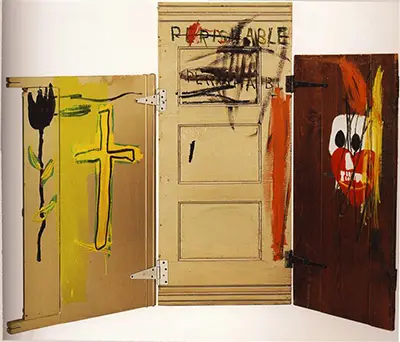The artist has taken two doors and the top of a desk and connected them together with domestic hinges. He paints some fairly simple artworks onto each of the three panels, with the word "Perishable" written twice on the central panel. He would cross out one instance of this word, suggesting the end of something significant. He used this technique elsewhere, sometimes to symolise mortality in the same way that he also used the skull from time to time. Most believe that this overall project was intended as a respectful homage to the life of Andy Warhol.
Basquiat did follow and appreciate more traditional western art, particularly the Italian Renaissance. Despite working in a very different manner to these great masters, he is known to have highly respected the likes of Titian and Da Vinci. He therefore would have come across a number of triptychs during his time studying this era, most of which came from Italy as well as some regions of Northern Europe. Much of the art produced at this time would have a specific location planned for it to be hung, which sometimes impacted the style, even shape, of the designed piece. In some cases artists would have to work around architectural elements in order to make the commissioned painting fit correctly. There were also many murals during this period as well which would be applied directly onto the wall or ceiling, normally within a religious venue.
Hieronymus Bosch was perhaps the finest exponent of triptychs, producing a good number of artworks in this format, where several different panels are connected together through hinges which allows the overall piece to be opened and closed. This means that each piece must be painted on both sides, so that there is art to enjoy regardless of which position the item has been left in. These would often be then installed within churches and generally the open format would contain the more important artworks, particularly the central panel which itself would carry the key painting. Normally the side panel paintings would serve as supporting elements to the overall theme, whatever that was. Some of Bosch's most famous triptych paintings included The Garden of Earthly Delights, Haywain Triptych and The Last Judgement.


